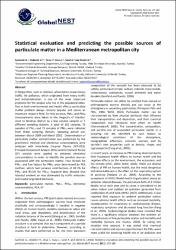| dc.contributor.author | Summak, G. | |
| dc.contributor.author | Özdemir, H. | |
| dc.contributor.author | Oruç, I | |
| dc.contributor.author | Kuzu, L. | |
| dc.contributor.author | Saral, A. | |
| dc.contributor.author | Demir, G. | |
| dc.date.accessioned | 2021-12-12T17:01:53Z | |
| dc.date.available | 2021-12-12T17:01:53Z | |
| dc.date.issued | 2018 | |
| dc.identifier.issn | 1790-7632 | |
| dc.identifier.uri | https://doi.org/10.30955/gnj.002333 | |
| dc.identifier.uri | https://hdl.handle.net/20.500.11857/3322 | |
| dc.description.abstract | In Mega-cities, such as Istanbul, urbanization causes heavy traffic. Air pollution, which originated from heavy traffic and industrialization, is one of the most important problems for the people who live in the populated cities. Due to both environmental and health effects, particulate matter problem always remains popular and serves an important research field. For this purpose, PM2.5 and PM10 measurements were taken in the megacity of Istanbul, close to Besiktas district by a low volume sampler at 5 different sampling stations. A total of 150 samples, 75 samples of PM2.5 and 75 samples of PM10 were collected from these sampling stations. Sampling period was between March 2009 and March 2010. Determination of particulate matter concentration was performed by the gravimetric method and elemental concentrations were analyzed with Inductively Coupled Plasma (ICP-OES). Principal Component Analysis (PCA) and Enrichment Factor (EF) analysis were applied to obtained elemental concentrations in order to identify the possible sources associated with the particulate matter. Four factors for PM2.5 and five factors for PM10 were determined by PCA method, which had variance contributions of 82.3% for PM2.5 and 83.5% for PM10. Acquired data showed that Istanbul ambient air was dominated by traffic emissions and crustal originated elements. | en_US |
| dc.description.sponsorship | TUBITAK (The Scientific and Technological Research Council of Turkey)Turkiye Bilimsel ve Teknolojik Arastirma Kurumu (TUBITAK) [108Y173] | en_US |
| dc.description.sponsorship | This research has been supported by TUBITAK (The Scientific and Technological Research Council of Turkey). Project number is 108Y173. | en_US |
| dc.language.iso | eng | en_US |
| dc.publisher | Global Network Environmental Science & Technology | en_US |
| dc.relation.ispartof | Global Nest Journal | en_US |
| dc.identifier.doi | 10.30955/gnj.002333 | |
| dc.rights | info:eu-repo/semantics/openAccess | en_US |
| dc.subject | particulate matter | en_US |
| dc.subject | PM2.5 | en_US |
| dc.subject | PM10 | en_US |
| dc.subject | elemental concentrations | en_US |
| dc.subject | PCA | en_US |
| dc.subject | EF | en_US |
| dc.title | Statistical evaluation and predicting the possible sources of particulate matter in a Mediterranean metropolitan city | en_US |
| dc.type | article | |
| dc.authorid | Kuzu, S. Levent/0000-0002-2251-3400 | |
| dc.department | Fakülteler, Mimarlık Fakültesi, Şehir ve Bölge Planlama Bölümü | |
| dc.identifier.volume | 20 | en_US |
| dc.identifier.startpage | 173 | en_US |
| dc.identifier.issue | 2 | en_US |
| dc.identifier.endpage | 180 | en_US |
| dc.relation.publicationcategory | Makale - Uluslararası Hakemli Dergi - Kurum Öğretim Elemanı | en_US |
| dc.authorscopusid | 55353341200 | |
| dc.authorscopusid | 36170067000 | |
| dc.authorscopusid | 55840612200 | |
| dc.authorscopusid | 52364270800 | |
| dc.authorscopusid | 7801334019 | |
| dc.authorscopusid | 7004830015 | |
| dc.identifier.wos | WOS:000446340100001 | en_US |
| dc.identifier.scopus | 2-s2.0-85055053130 | en_US |
| dc.authorwosid | Kuzu, S. Levent/R-5835-2019 | |



















